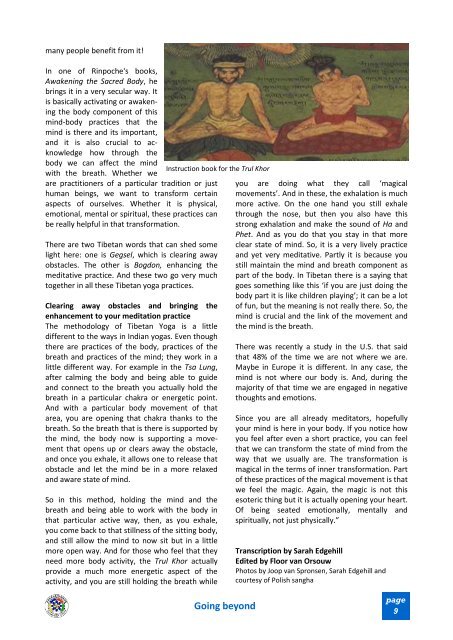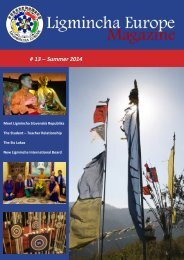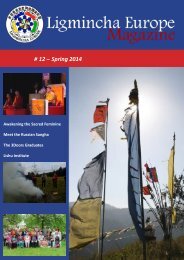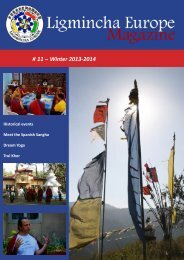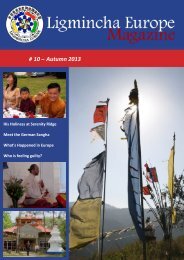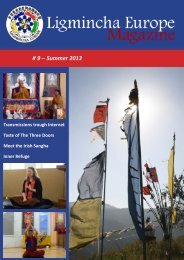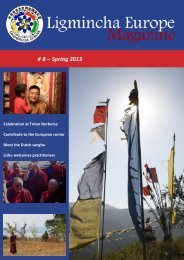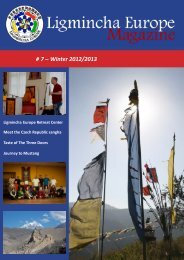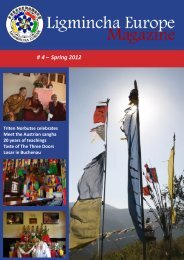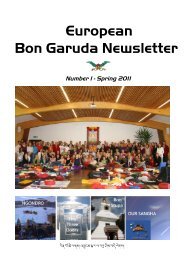Ligmincha Europe Magazine # 6 – Autumn 2012
European Magazine of the Ligmincha Sangha of Tenzin Wangyal Rinpoche. Informs about news, events, teachings and projects within the Bon-Buddhist Sangha.
European Magazine of the Ligmincha Sangha of Tenzin Wangyal Rinpoche. Informs about news, events, teachings and projects within the Bon-Buddhist Sangha.
You also want an ePaper? Increase the reach of your titles
YUMPU automatically turns print PDFs into web optimized ePapers that Google loves.
many people benefit from it!<br />
In one of Rinpoche's books,<br />
Awakening the Sacred Body, he<br />
brings it in a very secular way. It<br />
is basically activating or awakening<br />
the body component of this<br />
mind-body practices that the<br />
mind is there and its important,<br />
and it is also crucial to acknowledge<br />
how through the<br />
body we can affect the mind<br />
with the breath. Whether we<br />
are practitioners of a particular tradition or just<br />
human beings, we want to transform certain<br />
aspects of ourselves. Whether it is physical,<br />
emotional, mental or spiritual, these practices can<br />
be really helpful in that transformation.<br />
Instruction book for the Trul Khor<br />
There are two Tibetan words that can shed some<br />
light here: one is Gegsel, which is clearing away<br />
obstacles. The other is Bogdon, enhancing the<br />
meditative practice. And these two go very much<br />
together in all these Tibetan yoga practices.<br />
Clearing away obstacles and bringing the<br />
enhancement to your meditation practice<br />
The methodology of Tibetan Yoga is a little<br />
different to the ways in Indian yogas. Even though<br />
there are practices of the body, practices of the<br />
breath and practices of the mind; they work in a<br />
little different way. For example in the Tsa Lung,<br />
after calming the body and being able to guide<br />
and connect to the breath you actually hold the<br />
breath in a particular chakra or energetic point.<br />
And with a particular body movement of that<br />
area, you are opening that chakra thanks to the<br />
breath. So the breath that is there is supported by<br />
the mind, the body now is supporting a movement<br />
that opens up or clears away the obstacle,<br />
and once you exhale, it allows one to release that<br />
obstacle and let the mind be in a more relaxed<br />
and aware state of mind.<br />
So in this method, holding the mind and the<br />
breath and being able to work with the body in<br />
that particular active way, then, as you exhale,<br />
you come back to that stillness of the sitting body,<br />
and still allow the mind to now sit but in a little<br />
more open way. And for those who feel that they<br />
need more body activity, the Trul Khor actually<br />
provide a much more energetic aspect of the<br />
activity, and you are still holding the breath while<br />
Going beyond<br />
you are doing what they call ‘magical<br />
movements’. And in these, the exhalation is much<br />
more active. On the one hand you still exhale<br />
through the nose, but then you also have this<br />
strong exhalation and make the sound of Ha and<br />
Phet. And as you do that you stay in that more<br />
clear state of mind. So, it is a very lively practice<br />
and yet very meditative. Partly it is because you<br />
still maintain the mind and breath component as<br />
part of the body. In Tibetan there is a saying that<br />
goes something like this ‘if you are just doing the<br />
body part it is like children playing’; it can be a lot<br />
of fun, but the meaning is not really there. So, the<br />
mind is crucial and the link of the movement and<br />
the mind is the breath.<br />
There was recently a study in the U.S. that said<br />
that 48% of the time we are not where we are.<br />
Maybe in <strong>Europe</strong> it is different. In any case, the<br />
mind is not where our body is. And, during the<br />
majority of that time we are engaged in negative<br />
thoughts and emotions.<br />
Since you are all already meditators, hopefully<br />
your mind is here in your body. If you notice how<br />
you feel after even a short practice, you can feel<br />
that we can transform the state of mind from the<br />
way that we usually are. The transformation is<br />
magical in the terms of inner transformation. Part<br />
of these practices of the magical movement is that<br />
we feel the magic. Again, the magic is not this<br />
esoteric thing but it is actually opening your heart.<br />
Of being seated emotionally, mentally and<br />
spiritually, not just physically.”<br />
Transcription by Sarah Edgehill<br />
Edited by Floor van Orsouw<br />
Photos by Joop van Spronsen, Sarah Edgehill and<br />
courtesy of Polish sangha<br />
page<br />
9


